 (Source, edited)
(Source, edited)
Here’s the final part of this blogger’s post, which follows directly from where Part 2 left off (see here for Part 1). It’s a very good introduction to the origins of the Lolita trend in K-pop, and his earlier comments on Girl’s Day were very convincing, but unfortunately he makes some questionable generalizations here, especially about other girl-groups. On the other hand, what I disagreed with still got me thinking, and I learned a few things. I hope the same goes for readers too:
3. 아도르노의 문화산업론으로 본 롤리타 신드롬 / The Lolita Syndrome as seen through Adorno’s Culture Industry Theory
이러한 걸스데이의 노래와 활동에서 드러나는 롤리토크라시의 문제는 아도르노의 두 가지 관점에서 해석될 수 있다. 하나는 걸스데이와 같은 걸 그룹의 성장에 대한 문화적인 긍정적인 평가(즉, ‘남성 팬덤 문화의 형성’ 내지는 ‘대중음악에서 소외된 30-40대를 끌어들임으로써 10대에 치중되어있던 팬덤 문화의 편협성을 해소하고 나아가 문화적인 공동체를 형성했다’는 평가)가 사실은 기획사의 상업적인 목적 하에 철저하게 계획되어 그저 지금까지 개척되지 않았던 시장의 발견일 뿐이라는 점이다. 또 다른 하나는 이러한 걸스데이의 롤리토크라시의 성향은 “순응하지 않는 별종” 을 경제적으로 무능력하게 만들어 배제시키는 문화 산업의 획일화에 대한 강압에 의해 발생했다는 점이다.
The issue of Lolitocracy, revealed through Girl’s Day’s songs and promotional activities, can thus be interpreted through two of Adorno’s perspectives. One is that an optimistic cultural assessment on the growth of girl groups such as Girl’s Day (namely, ‘the development of a male fan culture’, or the evaluation that “by pulling those in their 30s and 40s in, who are ordinarily excluded from mainstream music, they have solved the narrow-mindedness of teen-focused fan culture, and have gone on to create a more comprehensive cultural community”.) cannot be true, as it is something that was thoroughly constructed to fit the commercial interests of entertainment companies; simply a market opportunity that had not yet been mined. The other assessment is that Girl’s Day’s demonstrated inclination towards Lolitocracy is something born out of the pressures of the standardization of a culture industry that seeks to alienate ‘any outliers that fail to conform’ by making them powerless financially.
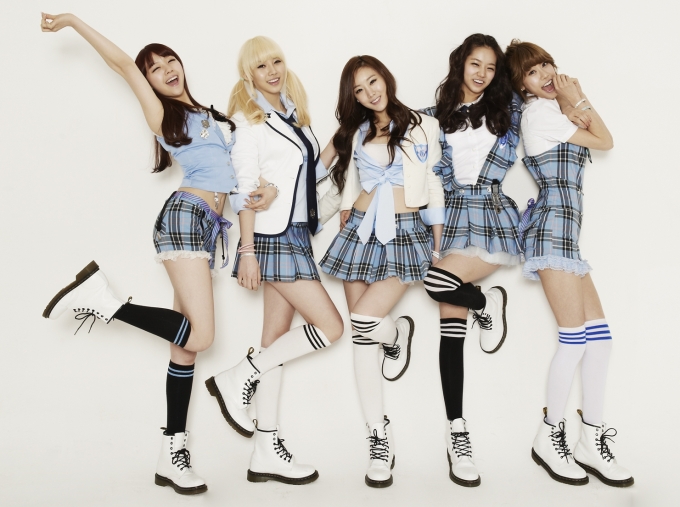 (Source)
(Source)
아도르노의 문화산업론에 따르면 문화산업에서의 다양성, 차이는 본질적인 차이가 아닌 소비자를 나누기 위한, 생산성의 극대화를 위한 하나의 도구일 뿐이다. 아도르노는 “어느 누구를 위해서도 무엇인가가 마련되어 있지만 그것은 누구도 그것으로부터 빠져나가지 못하게 하기 위해서다.”라고 밝힘으로써 문화산업의 다양성이 단순히 상업적인 의도에서 출발하는 도구적인 것이라는 사실을 밝히고 있다. 이런 관점에서 모든 대중 문화를 보면 모든 대중문화 현상들은 이 그 이면에 언제나 상업적인 의도를 내포하고 있으며, 그들이 쏟아내는 수많은 이미지와 상품들, 또한 그로 인해 파생되는 모든 현상들은 겉으로 보기에는 다양성의 확장으로 보일지 모르나 결국은 문화 산업의 논리 하에 소비자가 ‘구분’되고 ‘체계화’되는 과정일 뿐이다.
According to Adorno’s Culture Industry Theory, diversity or differentiation is simply another tool to classify consumers, thereby maximizing manufacturing ability, as opposed to an intrinsic difference. In his statement: “there is something prepared for anyone and everyone, but that is only so that no-one can escape from it”, he reveals the truth that any perceived diversity in the culture industry is essentially a tool driven by commercial motives. From this viewpoint, one can claim that commercial drivers underlie all pop cultural phenomena. The masses of images and products, and all further phenomena derived from them, may outwardly seem like growing diversity, but alas, only amounts to a process under the Culture Industry Theory, whereby consumers are classified and systemized.
또한 아도르노는 문화산업의 획일화의 원리도 지적한다. 그것은 문화산업의 자기보존적인 배타적인 성향인데 문화산업은 그와 다른 형태의 모든 문화산업을 ‘획일화’의 원리에 따르도록 강요한다. “사적인 문화독점” 안에서 모든 문화형태는 경제적인 논리의 심판에 따라 자연스럽게 시장에서 도태되며 이방인이 된다. 돈의 논리로 작동하는 문화산업에서 경제력은 생존력을 의미하며 결국 큰 주류와 다른 부류의 문화산업은 독점 문화산업의 폭력 앞에서 편입할 것인가 아니면 도태될 것인가 기로에 놓이게 된다.
Furthermore, Adorno looks to the principle of the standardization of the culture industry. This refers to the culture industry’s inclination toward self-preservation and exclusivity, as the industry stresses that all forms within the culture  industry conforms to one, standardized system. Within a ‘private culture monopoly’, all cultural forms naturally die out and become outsiders, under the laws governed by economic principle. In a system that operates on money, economic strength becomes synonymous with survival. Eventually, mainstream channels, as well as sub-classes of culture, are placed at a crossroads; either conform to the violence of the monopolized culture industry, or face extinction (source, right).
industry conforms to one, standardized system. Within a ‘private culture monopoly’, all cultural forms naturally die out and become outsiders, under the laws governed by economic principle. In a system that operates on money, economic strength becomes synonymous with survival. Eventually, mainstream channels, as well as sub-classes of culture, are placed at a crossroads; either conform to the violence of the monopolized culture industry, or face extinction (source, right).
먼저 문화산업의 상업적인 목적하의 구분 짓기가 걸 그룹 문화에 어떻게 드러나는지 살펴보자. 먼저 걸 그룹 문화 산업의 배후에 감추어진 상업적인 의도를 이해하기 위해선 이러한 걸 그룹 문화의 발전에 있어 무엇이 연예 기획사들을 모두 걸 그룹 시장에 집중하게 만들었는지 확인하는 과정이 필요하다. 왜 갑자기 2005년 이후 걸 그룹 열풍이 불기 시작했고 모든 연예기획사가 그러한 사업에 뛰어들기 시작한 것일까? 이러한 질문의 해답은 바로 새롭게 떠오른 중장년층 팬덤 문화의 발전이었다.
First let us examine how the culture industry’s profit-driven action of classification manifests itself in girl group culture. In order to understand the commercial interests that underlie the girl group market, we must first acknowledge the process by which entertainment companies came to focus on the girl group market. What caused ‘girl group fever’ to suddenly break out in 2005, and why did all the entertainment companies collectively dive in to the same market? The answer lies in the newly-excavated base of ‘middle-age fan culture’.
 (Source)
(Source)
팬덤 문화가 형성되기 시작한 1990년대 이후부터 지금까지 팬덤 문화는 ‘청소년 문화’의 하위문화로 취급되어 왔고 더 나아가 청소년 문화 자체를 팬덤의 문화로 볼 정도로 팬덤 문화는 지금까지 청소년의 고유한 문화영역으로 간주되어 왔다. 그러나 2007년, 원더걸스를 시작으로 소녀시대, 카라, 아이유에 이르기까지의 새로운 유형의 걸 그룹들은 팬덤문화의 영역을 ‘삼촌팬, 넥타이 부대’라 불리는 중장년층으로까지 확대시키면서 팬덤 문화에 대한 기존의 상식을 무너뜨렸다.
Ever since 1990 when fan culture first began to form, it has been treated solely as a sub-heading of ‘teen culture’. In fact, up until now, fan culture has been considered almost interchangeable with ‘youth’ or ‘teen culture’, seen as an area of culture inherent to adolescents. It was only in 2007, starting with the Wonder Girls, and continued through Girls’ Generation, KARA, and IU, that the fan culture of girl groups expanded its territory to older generations. Collectively known as the ‘[Neck]Tie Troops’, or ‘uncle fans’, this new branch broke down existing notions of fan culture.
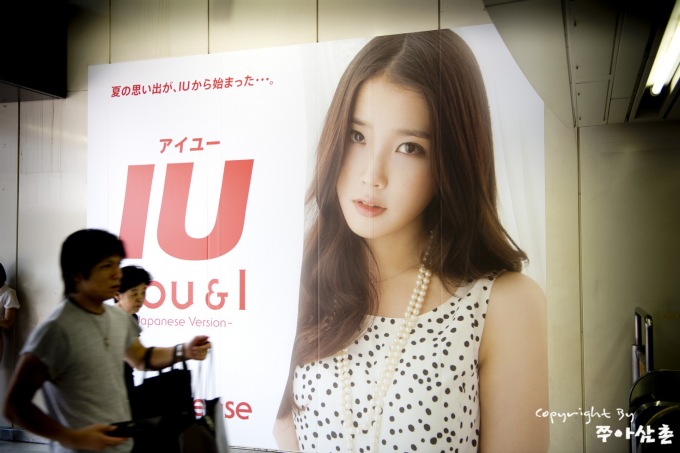 (Source)
(Source)
새롭게 떠오른 남성 팬덤 문화는 그 속성에서부터 그전 청소년을 중심으로 팬덤 문화와 확연한 차이를 보인다. 그들은 청소년들과 비교할 수 없는 소비력을 가진 주체들이다. 그들은 대부분 30-40대 중장년층으로써 한 국가의 생산력의 지표로써 안정적인 가정, 직장을 통해 그러한 생산력을 문화적인 컨텐츠에 소비할 수 있는 충분한 시간과 능력을 가진 주체들이다.
There are clear differences between the established youth-focused fan culture, and its newer, older counterpart. For one, [‘uncle fans’] possess a spending power that cannot even begin to be compared to that of teenagers. Generally aged between 30 and 40 years old, a class seen as the index by which a whole nation’s productive capacity is measured, their steady income and stable home environments allow them the necessary time and money to spend on cultural content.
 James — The Korean media was making similar observations about middle-aged fans — of BOTH sexes — back in 2009. See here for my translation of the above article.
James — The Korean media was making similar observations about middle-aged fans — of BOTH sexes — back in 2009. See here for my translation of the above article.
걸그룹 열풍의 시발점이었던 원더걸스의 ‘텔미’를 통해 발견된 이러한 삼촌 팬들은 문화산업에서 새로이 발견한 신대륙과 같은 소비처였다. 원더걸스가 ‘텔미’를 출시할 당시 “음반 산업은 사양 산업이 되는 것이 아닌가라는 비관적인 견해가 나올 정도로 ‘리메이크’ 방식이 판을 치는 진부한 음악이 주”를 이루고 있었고, 90년대를 풍미하던 10대 팬덤 문화를 기반으로 한 아이돌 시장도 음반판매방식에서 음원판매방식으로 변한 음악시장 내에서 점차 축소되고 있는 것이 현실이었다.
The culture industry’s discovery of this new-found niche of ‘uncle fans’ (resultant of the Wonder Girls song Tell Me) was akin to the discovery of a new continent in a commercial respect. At the time Tell Me was released, the industry was so dominated by stale music and clichéd ‘remakes’ that many were wondering whether the record business had become a sunset industry. The ‘idol’ market that had once ruled the 90’s from its foundation of teen fan culture was also fading, in a music industry that had made its shift from selling physical records, to the platform of digital sales.
[2000년 들어 디지털기술의 발전과 더불어 한국 음악계에서는 아이돌 스타들의 산업적 기반이던 음반시장이 몰락하고 음원시장으로 변화하는 구조적인 변화가 발생하였다. 이러한 상황 속에서 아이돌 스타들의 생존방식도 변화하게 되어 수직, 수평적 다각화를 통해 활로를 모색하던 중 연예기획사들은 이전까지는 다른 전략으로 새로운 유형의 아이돌을 등장시키게 된다.(김수아, 소녀 이미지의 볼거리화와 소비 방식의 구성, 미디어,젠더&문화, 2010 pp 83~84) ]
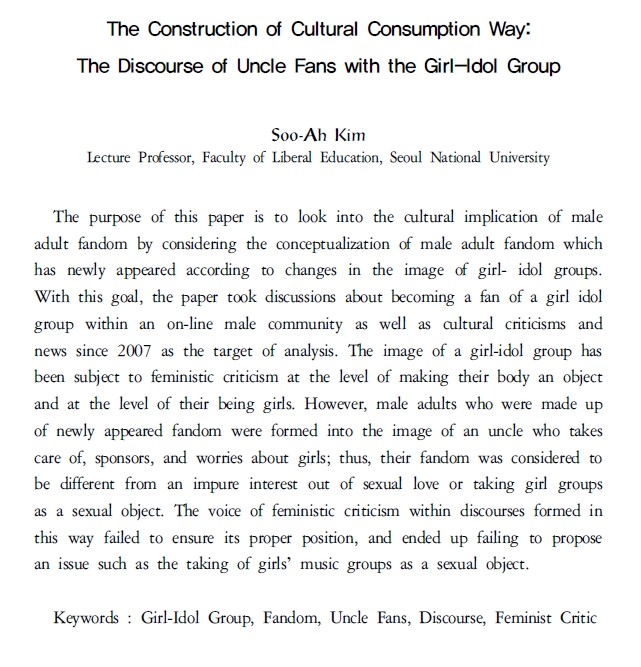 (Source)
(Source)
[The years since 2000 have seen the fall of the record business, which had founded itself on ‘idol’ stars, as well as was a structural shift into the digital sales market, influenced by the advance of digital technologies. These circumstances forced idol stars to change their survival tactics, and entertainment companies endeavored to diversify themselves through vertical and lateral means. Meanwhile, in the midst of such attempts to find solutions, entertainment companies came out a new type of ‘idol’ that would rely on new approaches. (Sooh-Ah Kim, The Construction of Cultural Consumption Way: The Discourse of Uncle Fans with the Girl-Idol Group; Media, Gender & Culture, Vol. 15; 2010, p83~p84)]
이런 상태에서 발견한 왕성한 소비력을 가진 ‘삼촌팬’의 발견은 음악시장의 판도를 바꿔놓게 되고 2000년대 후반 ‘걸그룹 열풍’을 일으키며 가요계의 큰 변화를 가져오게 된다.
Under the circumstances, the discovery of ‘uncle fans’ (and their large amounts of disposable income) was an obvious game changer in the music business, triggering the onset of ‘girl group fever’ in the latter half-decade of the 2000s. This delivered huge changes to the pop music industry.
 하지만 왜 갑자기 중장년층의 소위 ‘삼촌팬’들이 어린 아이들이 춤추고 노래하는 것에 대해 감응한 이유는 무엇일까? 여기에 대한 해답은 초창기 걸 그룹 열풍을 일으킨 SES, 핑클 과 현존하는 걸 그룹을 비교함으로써 찾을 수 있다. 가장 큰 특징은 구성원들의 나이가 현저히 낮아졌단 점이다.
하지만 왜 갑자기 중장년층의 소위 ‘삼촌팬’들이 어린 아이들이 춤추고 노래하는 것에 대해 감응한 이유는 무엇일까? 여기에 대한 해답은 초창기 걸 그룹 열풍을 일으킨 SES, 핑클 과 현존하는 걸 그룹을 비교함으로써 찾을 수 있다. 가장 큰 특징은 구성원들의 나이가 현저히 낮아졌단 점이다.
However, what could explain the middle-aged class of ‘uncle fans’’ sudden, positive response to the tunes and dances of teenagers? This can be addressed by making a comparison between the earliest, original girl group success such as S.E.S. and Fin.K.L, with the neo-girl groups that exist today. The biggest difference of all is that the ages of their members have decreased, and markedly so (source, right).
걸그룹 열풍의 중심에 서있는 소녀시대는 2007년 당시 멤버 전원이 고등학생이었으며, 걸 그룹 열풍의 시초를 알린 원더걸스 멤버들의 나이는 15세에서 19세에 걸쳐 있었다. 뿐만 아니라 이후 나오는 2ne1, 카라, 걸스데이, 포미닛, 시크릿, 티아라, 애프터 스쿨에 이르기 까지 이전 SES, 핑클 세대와 달리 평균연령이 만 20세를 넘지 않거나 최소한 10대의 멤버를 포함하는 등 ‘어리다’라는 특징을 가지고 시장에 나왔음을 알 수 있다.
Back in 2007, when Girl’s Generation was standing at the epicenter of girl group fever, all of its members were high school students. Similarly, the members of the pioneering Wonder Girls had an age range of 15 to 19 years, and the girl groups that followed, such as 2NE1, Kara, Girl’s Day, 4Minute, T-Ara, and After School all debuted with a definitive ‘young’ factor. Unlike the S.E.S/Fin.K.L generation, these new groups boast an ‘average age’ that does not surpass 20, or at the very least, include one teen-aged member.
 (Sources: Left, right)
(Sources: Left, right)
James — There are three big problems with the last two paragraphs:
1) Like in Part 2 where the author dubiously claimed that nearly 17 year-old Haeri and 17 year-old Minah of Girl’s Day were middle-schoolers, he is simply wrong about that ages of “the S.E.S/Fin.K.L generation” — not only were all members of both groups teenagers upon debut, with Shoo and Eugene of the former and Sung Yu-ri of the latter all 17, but there were many groups with even younger members before 2007, as discussed at Gusts of Popular Feeling. Instead, what was new was that young girl-group members’ dances and costumes were increasingly sexualized.
2) Even if the new groups mentioned did technically have teenage members upon their debuts (Bekah of After School was a woefully immature 19 years and 5 months for instance!), that does not make all the groups the same, and 2NE1’s, Kara’s, T-Ara’s, and After School’s “definitive young factor[s]” at debut — to the extent that they existed at all — can not be compared with, say, JYP’s decision (see below) to have then 15 year-old So-hee consistently giving the most sexualized performances of all the Wondergirls members (this was also the case with 15 year-old Hyuna, and was continued by Cube Entertainment when she later joined 4Minute).
3) Finally and crucially, by implying for the remainder of his post that the decreased ages of the girl-group members accounts for “the middle-aged class of uncle fans’ sudden, positive response to the tunes and dances of teenagers,” he:
a) Leaves you with the impression that Korean middle-aged men are all closet pedophiles, who jumped for joy at finally having girl-groups that catered to their sexual fantasies, and
b) Contradicts much of what he writes about Adorno and the dictates of the Culture Industry. In particular, 20 and 30-something girl-groups and female singers that promote sexually-assertive messages commensurate with their ages seem disproportionately targeted for censure or outright banning, in contrast to those that promote more immature, Lolita-like concepts of virginity, naivety, and passivity.
Or in short, while it’s not difficult to find the “bad girls” of K-pop out there if you wish (or “Pin-up grrrls,” I like to call them), it’s not like the Korean media tries to present a variety of gender and sexual roles for middle-aged uncle fans (or anyone) to choose from.
Continuing:
이러한 “미성년에 대한 금지된 욕망”에 대한 소구(召購)는 이전까지 흔히 공개적으로 시장화 되지 않았던 대중적인 무의식의 한 측면을 파고든 것이었다. 그 동안 대중예술계의 여성 이미지를 지배해온 “청순 코드나 섹시 코드는 식상해진지 오래”이므로 그런 와중에 등장한 풋풋한 여동생들이 단체로 발산하는 “대놓고 드러내지 않는 섹시함과 가시적으로 드러나는 귀여움”은 대중들의 욕망을 채어주기에 충분했던 것이다.
This targeted appeal at the ‘forbidden lust toward minors’ was hitherto an area that had never been openly commercialized, and sought to delve into a part of the public’s subconscious. Since the concept of ‘either wholesome or sexy’ had long gone stale, having been used for just about every portrayal of women in pop culture, the arrival of these fresh-faced girls, collectively projecting their implicit sexiness alongside their overt endearing qualities, was enough to satiate the public’s desires (source, right).
implicit sexiness alongside their overt endearing qualities, was enough to satiate the public’s desires (source, right).
이러한 ‘미성년’임을 강조하는 걸 그룹들의 시장전략은 남성대중들 사이에 음성적으로 존재하던 ‘미성년에 대한 성애적 욕망’을 아무런 죄책감 없이 소비할 수 있게 만든 ‘박진영’의 상업적인 전략의 산물, 원더걸스에서 시작되었다.
This market strategy that seeks to emphasize these girls’ adolescence is the brainchild of Park Jin Young, who, through the Wonder Girls, created a product that would allow guiltless indulgence of the ‘covert sexual desire towards adolescents’ hiding in the male psyche.
본격적인 걸 그룹 열풍의 시작을 알린 원더걸스는 90년대 실험적인 ‘섹시’ 이미지의 대명사 박진영의 야심작이었다. 박진영은 90년대 파격적인 섹시이미지를 기반으로 ‘엘리베이터안에서’, ‘그녀는 예뻤다’, ‘ 방문에서 침대까지’ 등의 노래를 히트시키며 성장한 가수였다. 또한 그가 제작한 노래는, 박지윤의 ‘성인식’, 엄정화의 ‘초대’와 같은 곡으로 성적은 은유를 강하게 담고 있는 노래들이었다. 그런 그가 JYP란 이름으로 처음 내놓은 그룹이 원더걸스였다는 점은 원더걸스가 다분히 그의 성 적 상품화의 전략에 의해 제작되었음을 충분히 예견할 수 있는 부분이다.
The Wonder Girls, who kick-started the phenomenon of ‘girl group fever’, was the venture of Park Jin Young, an artist synonymous with the experimental ‘sexy’ image of the 90’s. Park Jin Young founded his singing career on the shock factor of his blatantly sexual image, with hits such as In the Elevator, She Was Pretty, and From the Bedroom Door to the Bed. Additionally, the songs that he produced, some of which being Park Ji Yoon’s Coming-of-age Ceremony, and Um Jung Hwa’s Invitation, commonly relied on sexual metaphors. That he was the one to present the Wonder Girls as his first project under the moniker of ‘JYP’, and that this group was produced in line with his tactic of exploiting sex for commercial purposes, should come as a surprise to no one.
 (Sources: Left, right; see Korean Sociological Image #29 for a discussion of the posters)
(Sources: Left, right; see Korean Sociological Image #29 for a discussion of the posters)
결국 박진영은 원더걸스를 통해 대중들의 소녀에 대한 환상을 공공연히 투사하고 즐길 수 있는 통로를 만든 것이라 볼 수 있으며, 이러한 대중적 무의식을 공략한 그의 전략은 ‘텔미 현상’이라 불리는 30-40대 중장년층 팬덤문화를 만들며 ‘미성년에 대한 성 상품화’를 성공적으로 정착시켰다.
It can be said that Park Jin Young provided the public with a channel through which they could openly project and enjoy their fantasies toward young girls. Dubbed the ‘Tell Me Effect’, this stratagem targeted the public’s subconscious, and developed a fan culture in the 30s-40s age range, successfully launching the commodification of minors’ sexualities.
이러한 그의 전략은 마치 걸 그룹의 폭발적인 인기가 이전까지 대중가요에서 이방인으로 취급되던 중장년층을 대중문화의 영역으로 끌어들였다는 낙관론적인 견해가 얼마나 무지한 것인가를 확인시켜준다. 걸 그룹 중심의 대중가요의 흐름은 30대 중장년층의 문화적인 저변의 확대에서 기인하는 것이 아닌 그들의 음성적 성적 욕망을 자극하는 “각계각층을 위해 다양한 질의 대량생산물” 을 소비케 하기 위한 전략에서 나온 것일 뿐이다. 그저 지금까지 개척되지 않은 30-40대 중장년층의 남성시장이 ‘어리다는 이미지를 강조한 성적인 미끼’에 의해 개척 될 수 있다는 것을 확인한 선구자적인 박진영의 상업적 아이디어일 뿐이다. 다양성의 표면적인 모습은 결국 “세속적인 문화 산업 제작팀” 에 의해 특정 계층에 대해 소구하기 위한 허위적인 상품에 불과한 것이고, 아도르노의 생각대로 대중문화는 철저하게 상업적인 이윤의 논리 앞에 다양한 계층을 포함하기 위한 겉으론 다채롭지만 본질은 롤리타적 성애에 집착한 획일적인 “규격품” 에 지나지 않는다.
[Park Jin Young’s] strategy makes it clear how ignorant it would be to take a rosy view on the massive popularity of girl groups, and attribute to [the greater good] of integrating the previously-alienated older generation into mainstream pop culture. The trend towards girl group-focused pop culture is not something that is founded on a desire to expand the cultural base to include the older generation, so much as to appeal to their subconscious sexual desires; a stratagem to provide “mass-manufactured goods for all classes” for consumption. Simply put, it was a business idea thought of by Park Jin Young, who recognized that the as yet unacknowledged 30s-40s age bracket could be lured in, if using the bait of a sexual image that emphasizes the ‘young’ factor. To all intents and purposes, surface-level diversity is in reality little more than a spurious product, selected by a culture industry production team. Just as Adorno hypothesized, popular culture is strictly confined to the parameters of economic reasoning and commercial motives — in order to include all social strata, this product may don the disguise of diversity, but really amounts to no more than another standardized ‘off-the-shelf’ product, fixating on Lolita-esque lust.
 (See Korean Sociological Image #76: Gendered Innocence and “The Nation’s First Love” for a discussion of the above image)
(See Korean Sociological Image #76: Gendered Innocence and “The Nation’s First Love” for a discussion of the above image)
James — While JYP certainly deserves his reputation, it has to be admitted that he didn’t sexualize Suzy of Miss A like he did So-hee of the Wonder Girls. Likely, all the better to exploit her reluctant role as the “nation’s little sister” however, as discussed briefly below.
또한 이러한 롤로토크라시의 걸 그룹의 흥행은 대중가요에 기존에 존재하던 걸 그룹들을 모두 ‘롤리토크라시’라는 가치에 기반을 둔 “획일화”의 산물로 만들어버렸다. 더 이상 걸 그룹들은 새로운 컨셉으로 나오지 않는다. 겉으로는 다양한 음악적인 양식과 스타일을 담고 있는 것처럼 보이지만 실상 그들이 홍보하는 것은 노래의 양식, 스타일보다는 멤버들의 어린 나이이며, 거기서 나오는 은근한 섹시함이다. 오직 바뀌는 것은 ‘어림’과 ‘섹시함’을 어떤 비율로 혼합 하였는가 이며 그 외의 모든 요소는 부차적이다.
What’s more, the success of girl groups ruled by Lolitocracy has forced preexisting girl groups in pop music into becoming subjects of Lolitocracy-based standardization. Girl groups no longer come out with new concepts. On the surface, they appear to be carrying a broad range of musical forms and styles, but in reality, what they are promoting is not their musical genres or styles, but the members’ young ages, and the implicit sexual connotations that this elicits. The only thing that changes from group to group is the ratio at which they mix ‘young’ with ‘sexy’, and all other factors are peripheral.
이러한 흐름은 논문에서 나온 걸스데이의 예처럼 이러한 흐름에 따르지 않는 그룹을 상업적으로 외면 받아 파산되도록 버려두도록 한다. 흐름은 더 큰 흐름을 낳고 새로움은 거대한 흐름에 휩쓸려 사라진다. 이러한 획일성의 흐름은 걸스데이를 기존 여성 락 그룹이라는 음악적인 독창성을 버리고 기존 흐름에 편승할 수밖에 없도록 만들었다. 이러한 예는 브라운아이드걸스, 써니힐 등 기존 모토를 버리고 하나같이 획일화되어버린 많은 걸 그룹에서도 확인할 수 있다.
Such trends, as exemplified earlier through the case of Girl’s Day, filter out non-conformers by leaving them to go bankrupt. These patterns birth wider currents, and innovation is swept away, never to be seen again. The same current of systematization left Girl’s Day no choice but to rid themselves of their musical individuality (of being a female rock group) and get on the bandwagon, like everyone else. This pattern can be witnessed in many other girl groups such as the Brown Eyed Girls and Sunny Hill, both of whom gave up their original mottos and ended up conforming to the system.
James — Again the author really loses me here, as both groups (including the former’s sub-units) are well known for socially-progressive messages and defying the girl-group norm, with Sunny Hill only taking a small step towards the “mainstream” nearly a year after this post was written (albeit much to my regret!).
 (Source)
(Source)
결론 / Conclusion
원더걸스 흥행으로 생긴 걸 그룹 흥행과 그 획일화의 블랙홀은 빠른 속도로 확장하고 있다. 또한 점점 노골적인 성적 어필을 암시하는 그룹들이 오빠, 삼촌 이미지에 직접적으로 소구하는 모습을 보고 있노라면 아도르노가 말했듯 대중문화가 “장사 이외에는 아무것도 아닌” “허섭스레기” 라는 사실을 너무도 잘 보여주고 있는 것 같다.
The black hole that is the success of girl groups as triggered by the Wonder Girls, and its standardization, is growing with considerable speed. Furthermore, looking at these groups that are becoming more and more aggressive in their sexual appeals to this specific [audience] of ‘oppas’ and ‘uncles’, it’s all too clear that pop culture is indeed “garbage,” and “no more than profit-making,” just as Adorno claimed.
이러한 대중문화의 획일화의 문제는 비단 걸 그룹 시장에서만의 문제는 아닐 것이다. 텔레비전 오락방송, 드라마부터 라디오, 영화, 음악에 이르기 까지 모든 문화 분야는 그 획일화의 길을 걷고 있다. 할리우드 영화의 흐름을 담지 못한 영화는 ‘줄거리가 허술하다’라는 비난을 받으며 스크린에서 쫓겨나고 새로운 양식의 음악은 오로지 그런 음악을 찾아 소비하는 극소수의 사람들에게나 존재하는 것이다. 같은 내용의 수많은 컨텐츠들은 결국 같은 방식의 소비만을 강요하게 되고 대중들은 익숙해지고 무감각해지며 다른 것들에 대해 탐구할 만한 의지를 잃고 “영원한 소비자” 로 전락하는 것이다.
The issue of standardized pop culture can’t be a problem exclusive to the girl group market, however. Television entertainment shows and dramas, radio, films and music – they are all walking the same path towards standardization and conformity. Films that do not follow in Hollywood’s footsteps are criticized as having ‘a sub-par plot’ and are chased off the screen, and new styles of music only ever reach the small minority who actively seek to consume them. The same old material gets replicated innumerably, all pushing the same methods of consumption. The masses become accustomed to it, numb, having lost their will to discover anything new, and gradually degenerate into ‘eternal consumers’.
하지만 걸 그룹 문화에 있어 획일화의 문제에 앞서 하나 더 주목해야 할 것은 이러한 문화산업이 팔고 있는 가치가 “미성년의 성”이라는 점이다. 청소년이 아무리 겉보기에 육체적으로 성숙하였다고 할지라도 그러한 이유로 성인 사회에 존재하는 성적 소비의 대상으로 여긴다는 것은 어불성설이다. 하지만 안타깝게도 돈에 혈안이 된 문화산업의 생산자들은 이제 성 개방 풍조를 등에 업고 예술이라는 이름하에 보호받아야 할 ‘미성년의 성’마저 상품화했다. 그들은 이러한 소비에 대한 죄책감을 희석시키기 위해 ‘삼촌팬’, ‘국민 여동생’이라는 신조어를 만들어 내며 문제가 있는 사안마저 교묘한 방법으로 소비되도록 포장하며 가공했다.
Having said this, more salient than the criticism of standardization in girl group culture is the fact that the very value being sold by the culture industry is the sexuality of minors. No matter how mature teenagers may appear physically, it is ridiculous to assume that we may consider them appropriate subjects of sexual consumption in an adult society. But regrettably, the money-crazed manufacturers of the culture industry have now commodified even the sexuality of minors, something that should be protected in the name of art, and pass it off as an opening trend. In an attempt to justify the guilt that follows such problematic consumption, they have taken to creating neologisms such as ‘uncle fan’ or ‘nation’s little sister’ — thus, taking even a controversial issue such as this, and slyly packaging it into readily-consumable products.
걸그룹 전성시대의 소녀 아이돌은 서슴없이 몸매를 강조하는 일본식 교복 의상을 메인 테마로 하여 데뷔하며, 짧은 의상과 몸의 움직임과 선을 강조하는 춤을 춘다.
The young female ‘idols’ of the girl group golden age debut wearing costumes reminiscent of Japanese-style uniforms which unscrupulously accentuate their figures, and perform dance routines that are choreographed to emphasize their skimpy outfits as well as the movements and silhouettes of their bodies (source, right).
that are choreographed to emphasize their skimpy outfits as well as the movements and silhouettes of their bodies (source, right).
이러한 의도되었거나 우연인 것처럼 가장된 성애적 이미지들은 결국 대중들의 시선을 청소년에 성에 집중시킴으로써 마땅히 성적으로 보호받아야할 청소년을 위험에 노출시키고 있는 것이다.
Such sexual portrayals, whether explicit, or construed to appear ‘accidental’, draw the eye of the public to the sexuality of minors, and as a result [these girls] become exposed, where sexuality is concerned, to the very dangers from which they should rightfully be protected.
최근 빈번하게 발생하는 청소년성범죄문제와 근래에 발생한 아동성범죄과 이러한 대중문화의 양상과 직접적인 관계가 있다는 연구는 아직 존재하지 않으나 최근 들어 급속도로 증가하는 청소년성범죄율과 걸 그룹 문화의 성장률을 비교해볼 때 이러한 성상품화 전략이 청소년성범죄와 무관하다고 보기 힘들게 만든다.
So far, no existing studies can confirm a direct correlation linking the above-mentioned aspects of popular culture with the issue of rising rates of now-frequently occurring juvenile sex offenses and of recent child sex offenses. However, upon examining the ever-increasing crime rates in juvenile sex offense cases against the surge of girl group culture, it is difficult to conclude that such sex-peddling [commercial] strategies would have zero relation to juvenile sex offenses.
James — To the best of my knowledge, rates are not rising, and only appear to be so due to sensationalist reporting. Certainly this was the case in July 2010 at least, when the Korean media sparked the still-continuing, albeit very belated and necessary mania about child sex offenses.
요란한 음악과 점점 화려해지는 대중문화의 이면에 점점 더 희석되는 성윤리의식이 보인다. 우리는 어쩌면 이런 식으로 우리 사회의 반드시 지켜야할 가치를 가벼운 유흥과 교환하며 살아가고 있는지도 모른다. 언젠간 이러한 걸 그룹 열풍도 끝날 테지만 걸 그룹 문화가 제시한 ‘미성년도 성적 대상이 될 수 있다’는 무너져 버린 성 의식은 오랫동안 대중들의 의식 속에서 수많은 윤리문제를 쏟아내며 지속될 것 같다.
Looking past the flashy music of pop culture that continues to be more and more extravagant, one can see the disintegration of [healthy] attitudes towards sexual ethics. It seems that we are perhaps letting crucial sexual values in society slide, in exchange for a bit of light entertainment. ‘Girl group fever’ will pass someday, but this flawed attitude presented by girl group culture (the notion that minors may be appropriately thought of as objects of sexual desire) will surely continue to raise a plethora of ethical concerns in the collective consciousness of the public for a long time yet (end).
(Thanks very much to Janne Song for translating Part 3!)
Related Posts:
• So Hot by the Wondergirls (원더걸스): Lyrics, Translation, & Explanation
• Consent is Sexy, Part 3: Female President by Girl’s Day #FAIL
• Korean Girl Rockers, Defying the Stereotypes
• Korean Sociological Image #76: Gendered Innocence and “The Nation’s First Love”
• Ajosshis & Girls’ Generation: The Panic Interface of Korean Sexuality
• What did Depraved Oppas do to Girls’ Generation? Part 1
• “Cleavage out, Legs in” — The Key to Understanding Ajosshi Fandom?



















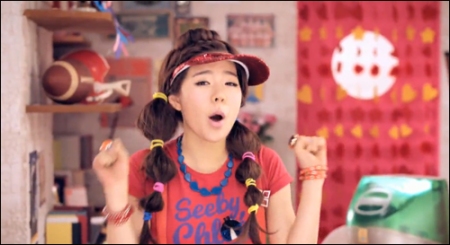

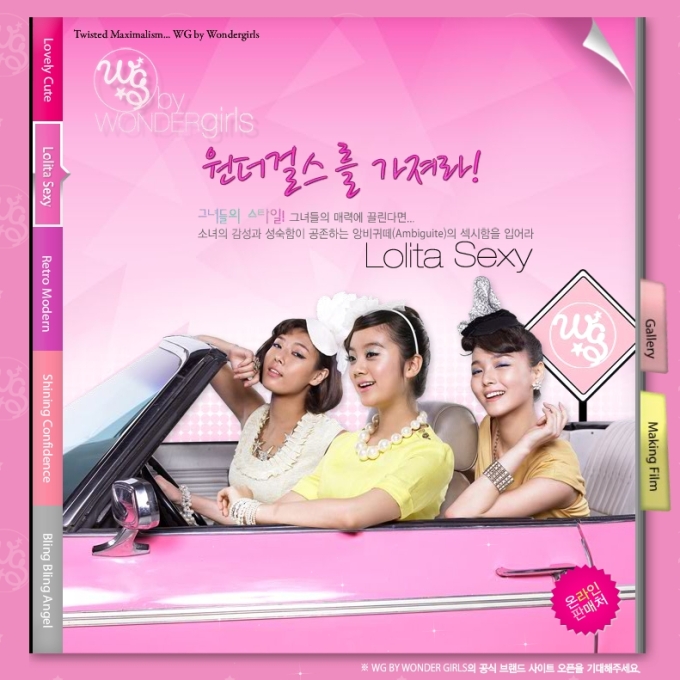


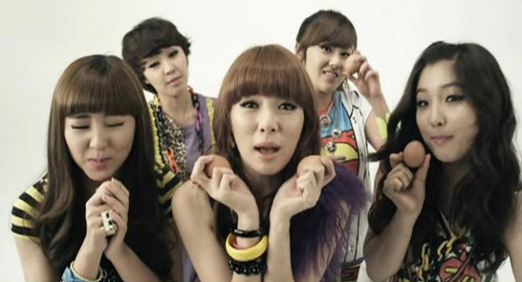

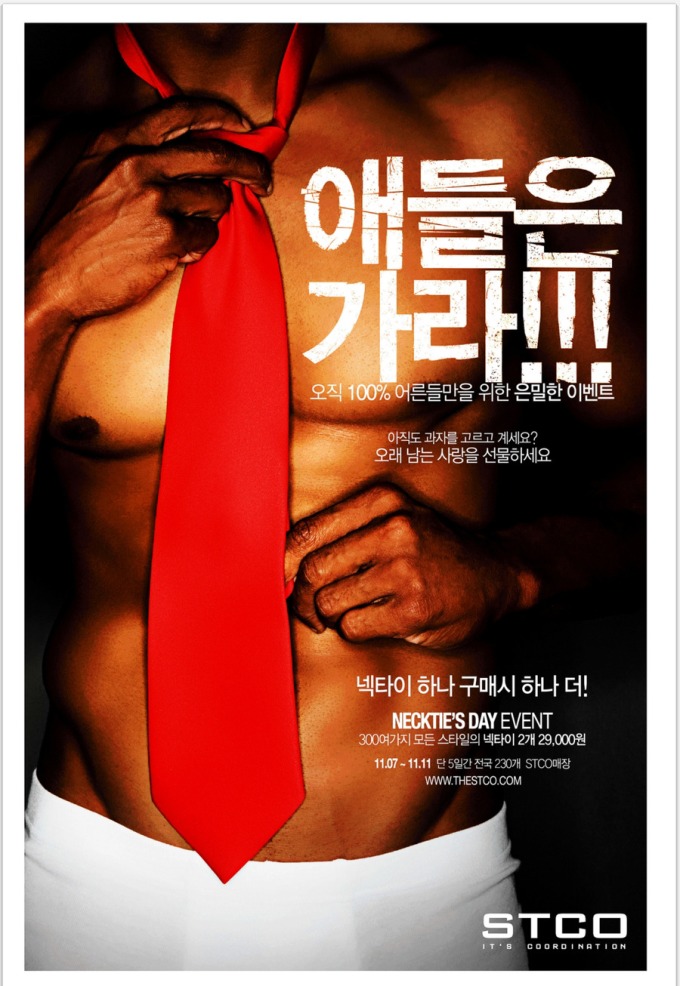




 (
( 